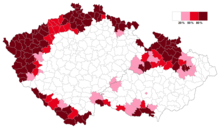
Back السوديت Arabic Судэцкая вобласць Byelorussian Судетска област Bulgarian সুদাতেনল্যান্ড Bengali/Bangla Sudetenland Catalan Sudety Czech Sudetenland Welsh Sudeterlandet Danish Sudetenland German Σουδητία Greek
This article needs additional citations for verification. (September 2011) |

The Sudetenland (/suːˈdeɪtənlænd/ ⓘ soo-DAY-tən-land, German: [zuˈdeːtn̩ˌlant]; Czech and Slovak: Sudety) is the historical German name for the northern, southern, and western areas of former Czechoslovakia which were inhabited primarily by Sudeten Germans. These German speakers had predominated in the border districts of Bohemia, Moravia, and Czech Silesia since the Middle Ages. Since the 9th century the Sudetenland had been an integral part of the Czech state (first within the Duchy of Bohemia and later the Kingdom of Bohemia) both geographically and politically.
The word "Sudetenland" did not come into being until the early part of the 20th century and did not come to prominence until almost two decades into the century, after World War I, when Austria-Hungary was dismembered and the Sudeten Germans found themselves living in the new country of Czechoslovakia. The Sudeten crisis of 1938 was provoked by the Pan-Germanist demands of Nazi Germany that the Sudetenland be annexed to Germany, which happened after the later Munich Agreement. Part of the borderland was invaded and annexed by Poland. Afterwards, the formerly unrecognized Sudetenland became an administrative division of Germany. When Czechoslovakia was reconstituted after World War II, the Sudeten Germans were expelled and the region today is inhabited almost exclusively by Czech speakers.
The word Sudetenland is a German compound of Land, meaning "country", and Sudeten, the name of the Sudeten Mountains, which run along the northern Czech border and Lower Silesia (now in Poland). The Sudetenland encompassed areas well beyond those mountains, however.
Parts of the now-Czech regions of Karlovy Vary, Liberec, Olomouc, Moravia-Silesia, South Moravia and Ústí nad Labem are within the former Sudetenland.
© MMXXIII Rich X Search. We shall prevail. All rights reserved. Rich X Search